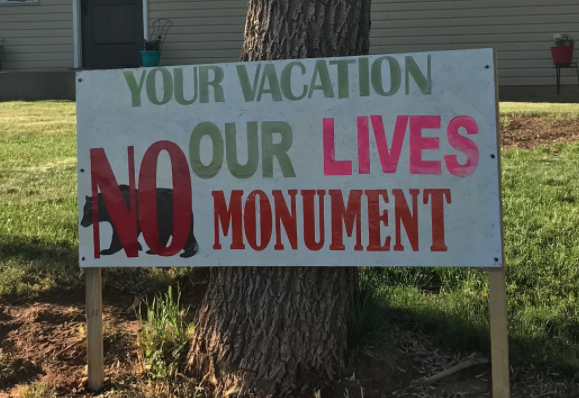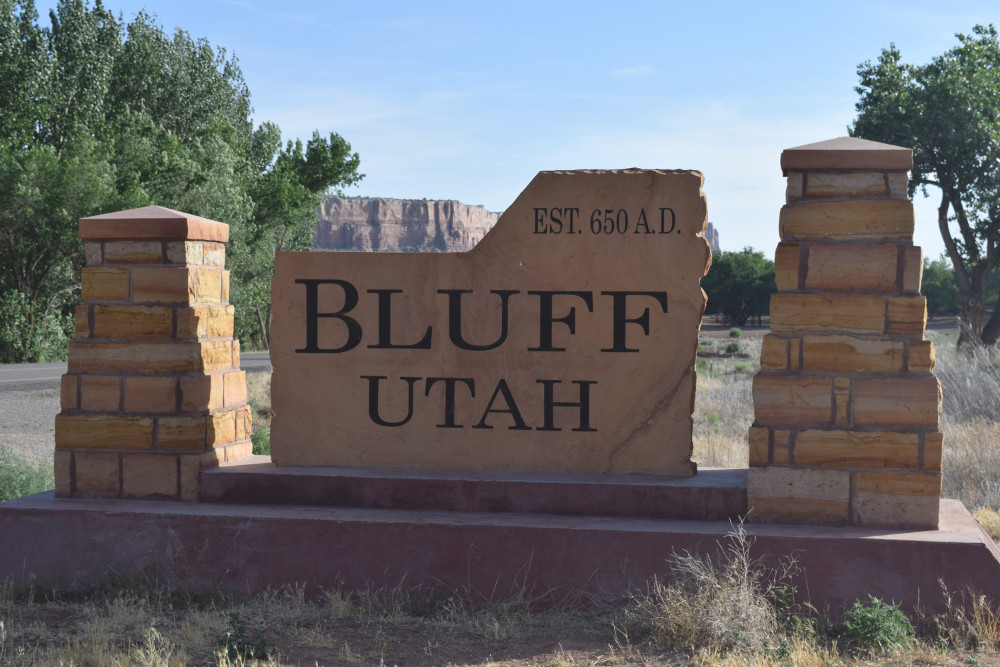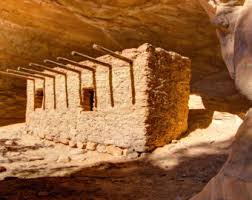On entering Blanding, Utah
On a front yard in Blanding
I went hiking in the new Bears Ears National Monument in Utah with Crow Canyon Archaeological Center. Not everyone is happy with Obama’s designation of the Monument, and Trump may shrink the Monument.
Bluff and Blanding are both on the edge of the new Monument, and are only twenty-five miles part, but they have opposed views on the Monument. Bluff was founded by the Mormons, but the flooding from the San Juan River made farming impossible, and they moved up to Blanding, leaving Bluff to be taken over by New West types, especially outfitters and archaeologists. The area is dense with sites ranging from 7000 BC to 1250 or so.
There are an estimated 100,000 archaeological sites scattered across the Bears Ears cultural landscape, according to the Bears Inter-Tribal Coalition’s national monument proposal
The Revelator did a series of article son the Monument; the last one was The Fight Over Bears Ears: A Tale of Two Towns.
When it comes to the fight over Bears Ears National Monument, the stark differences in attitudes toward the monument designation between residents of Bluff and nearby Blanding are literally 15 centuries apart.
The roadside signs welcoming travelers to each community located along U.S. 191, one of the nation’s most beautiful highways, succinctly sum up the difference between the two communities.
In a respectful nod toward the ancient settlements that first appeared along the banks of the San Juan River, Bluff’s welcome signs declare that the unincorporated community of about 300 was founded in 650 A.D.
Blanding is Mormon, alcohol-free, and largely edible-food-free.
The Obama administration worked with the five Native American groups in the area to develop a way to protect the area and give Indians access for traditional uses. The Mormons have a long history of pot-stealing from public land and seem to regard public land as their private property.
Like others in his community, Blanding businessman Joe Lyman, currently serving his third term on the Blanding City Council, turns to a far-right fringe analysis to buttress his anti-monument stance.
Lyman, a descendant of Mormon pioneers who founded Bluff in 1880 after a harrowing trek through the rugged mountains, provided The Revelator with a copy of a report written by J.R. Carlson of Stillwater Technical Solutions of Garden City, Kansas, which was presented to the San Juan County Commission in October 2016.
Carlson’s report claims, incorrectly, that the president doesn’t have the authority to proclaim a national monument under the Antiquities Act of 1906, and that the 43 grazing allotments on Bear Ears National Monument are lands that are not “owned or controlled” by the federal government and therefore not eligible for monument inclusion.
Carlson, the executive director of the Kansas Natural Resource Coalition — an alliance of county governments that engage with federal agencies on natural resource policies — argues in the document that “for purposes of a monument designation, grazing allotments (districts) are a limited-fee, surface title property, and as a result such lands are not owned or controlled by the Federal government.”
There is no widely accepted legal basis to support Carlson’s claim, which is often cited by ranchers seeking to assume control of federal land. The federal government has been leasing federal land to ranchers since passage of the Taylor Grazing Act of 1934.
The leases are at bargain rates so the Federal government has been subsidizing ranchers for almost a century. Even worse, the land has been overgrazed. It is really too dry to run cattle on it without ruining it, especially as the area has a centuries-old pattern of periodic droughts.
The land in the new Monument was BLM (Bureau of Land Management) and Forest Service land, which was open to a variety of uses:
Lyman says Blanding has long relied on the tax base created from grazing, mining and timber harvesting on federal lands, including Manti-La Sal National Forest, that are now included in Bears Ears National Monument. He worries the national monument designation will reduce economic development opportunities.
“Continued multiple use of the land is vital to our way of life and our economic survival,” he says. “An increase in seasonal tourism is no replacement for a diverse and healthy economy.”
But I have been told that this way of life is heavily subsidized by the government by fees that are far lower than equivalent private fees. Moreover, grazing and mining are destructive of a very fragile landscape.
I have heard mostly from the Bluffoons, as the inhabitants of Bluff call themselves, although they can be a bit paranoid about the Mormons, who do seem to be making an effort to repopulate Bluff.
A businessman in Bluff analyzed the situation:
Simpson, a tax attorney by training, says most of the people living in Bluff support the national monument and embrace a tourist-based economy that they believe is far more sustainable than relying on the boom-bust extractive industries that have historically underpinned the regional economy.
“You have Bluff, which is a liberal community, right in the middle of an extremely conservative, extremely LDS (Church of Jesus Christ of Latter-Day Saints) area,” he says. “The position of Bluff doesn’t mesh well with the folks in Blanding.” Simpson also knows quite a few people who are opposed to the monument. Many of them are Mormon pioneer descendants, he says, and have strong ties to the land that their ancestors settled in the late 19th century.
There is resentment, Simpson says, that a huge part of what they see as their back yard is now being set aside as a national monument — particularly since it was at the request of American Indian tribes that were forcibly removed from much of their traditional lands, including Bears Ears, more than 150 years ago.
The resentment toward American Indians by the local population was readily apparent during the debate leading up to the monument designation. The Salt Lake Tribune reported that San Juan County Commissioner Phil Lyman told Navajo leaders that they “lost the war” and have no right to comment on public land management. Ranchers in San Juan County were also telling American Indians to “get back on the reservation.”
The Indians have gotten a raw deal from Euro-Americans; not all wrongs can be righted, but we can certainly treat them with respect as the first settlers of this continent and help them integrate into modern society while preserving as much of their culture as they choose.
I am sympathetic to the people of Blanding who want to continue living there and making a living. Seasonal tourism is not enough, I agree, but developing the vast recreational and cultural potential of the area can also make it attractive for businesses and retirees to locate there. In any case, should the Federal government through the low fees that make extractive uses profitable subsidize uses that destroy public lands, which should be held in trust for all Americans and future generations.
If the Monument is rescinded, the government should make sure first of all that the fees it charges are the same as the fees that private land owners charge and secondly use that money to restore the lands that have been damaged and to preserve archaeological sites.



